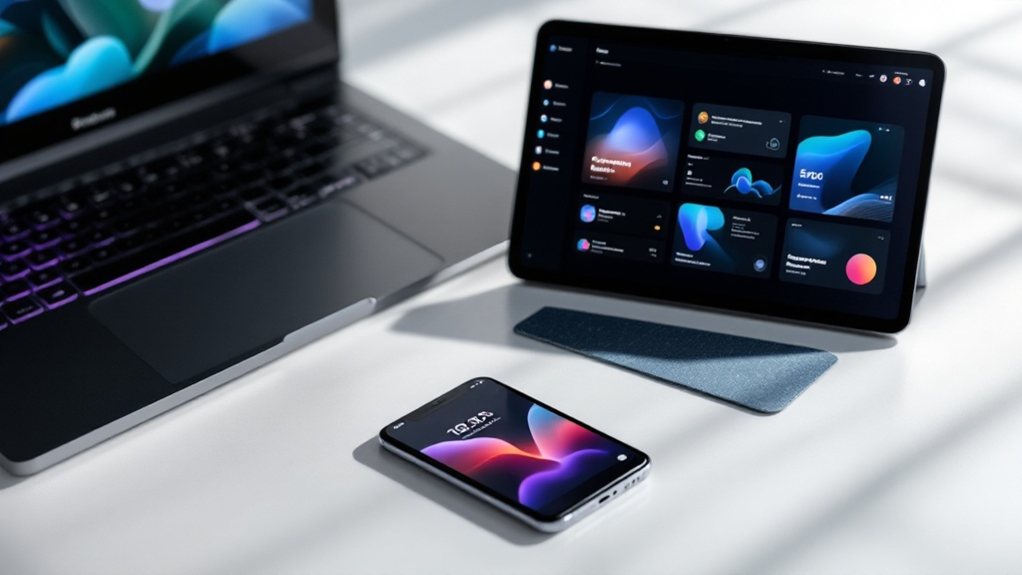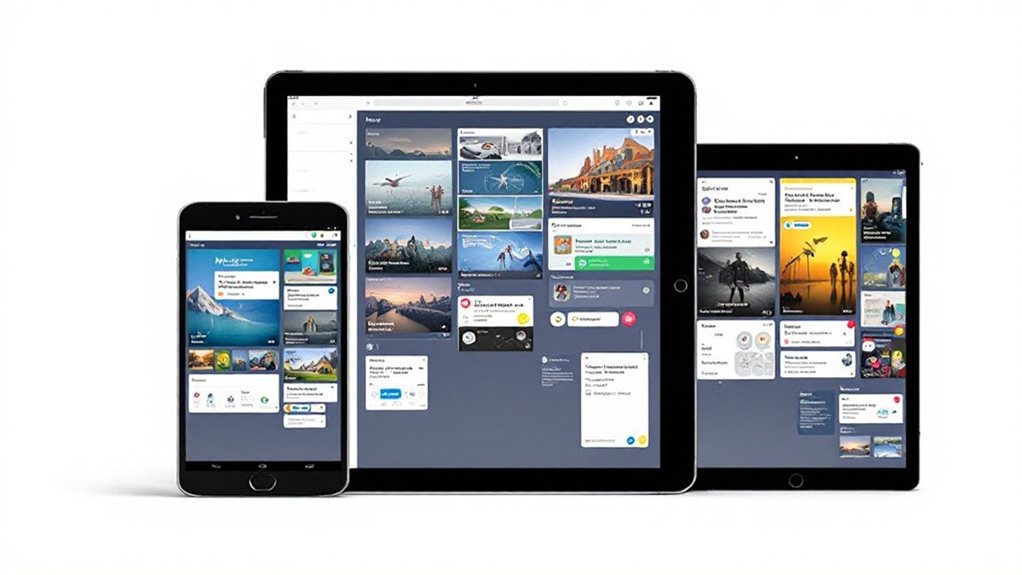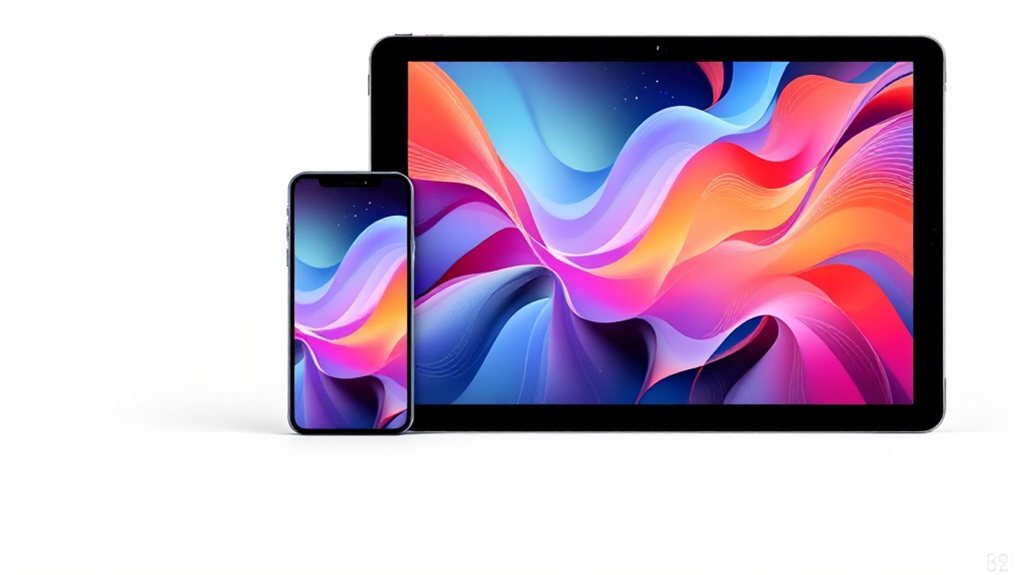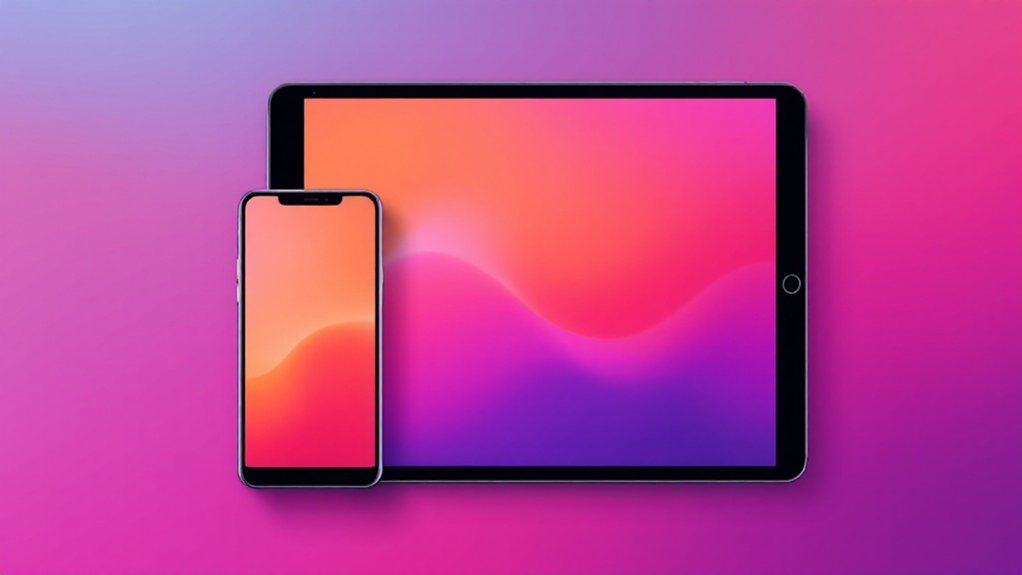Delivering seamless cross-device experiences starts with understanding your users' needs and pain points. You'll want to maintain consistent branding, optimize content for each platform, and enable smooth navigation. Contextual awareness and performance optimization are also key. Continuously iterate and test your approach to ensure you're meeting evolving user expectations. By adopting a comprehensive, user-centric strategy, you can elevate your brand's cross-device experience and foster long-term engagement.
Key Takeaways
- Conduct thorough user research to identify needs, pain points, and behaviors across various devices and touchpoints.
- Maintain a consistent visual brand, design system, and content optimization to deliver a cohesive user experience.
- Adapt navigation, interactions, and interfaces based on the user's device context to ensure seamless cross-device transitions.
- Leverage performance optimization techniques, responsive design, and comprehensive testing to deliver fast and efficient cross-device experiences.
- Adopt an iterative, data-driven approach to continuously improve the cross-device experience based on user feedback and analytics.
Understanding the Multi-Device Landscape

In today's tech-savvy world, you've likely grown accustomed to using a multitude of devices to accomplish your daily tasks. From smartphones and tablets to laptops and desktops, the modern user journey often involves seamlessly transitioning between various platforms. This multi-device landscape has become the norm, presenting both opportunities and challenges for designers and developers. Understanding the intricacies of cross-device user behavior is crucial in crafting experiences that cater to the needs and expectations of your audience. By embracing a holistic approach, you can design intuitive interfaces that effortlessly bridge the gap between devices, ensuring a cohesive and engaging user experience.
Identifying User Needs and Pain Points
To design a truly seamless cross-device experience, you'll need to deeply understand your users' needs and pain points. Start by conducting thorough user research across various devices and touchpoints. Gather insights on how they move between devices, their expectations, and the challenges they face. Pay close attention to pain points like inconsistent branding, disrupted workflows, and difficulties syncing data. Use this knowledge to create user personas and empathy maps that capture their goals, motivations, and frustrations. Armed with this understanding, you can then design seamless, context-aware experiences that address their needs and elevate their cross-device journey.
Designing for Consistent Visual Branding

Consistent visual branding is crucial for crafting a seamless cross-device experience. It ensures users recognize your product or service regardless of the device they're using. Stick to a cohesive color palette, typography, and iconography across all touchpoints. This builds trust and brand recall. Ensure your UI elements like buttons, menus, and forms maintain a consistent look and feel. Leverage design systems to streamline the creation of visually harmonious interfaces. Maintaining a strong visual identity strengthens your brand positioning and makes navigating your product intuitive. Invest in crafting a polished, recognizable aesthetic to elevate the cross-device user experience.
Optimizing Content Delivery Across Devices
Crafting consistent visuals is just the start. Optimizing content delivery across devices requires a strategic approach. Ensure your content is responsive, adjusting seamlessly to various screen sizes and orientations. Leverage techniques like lazy loading and progressive web apps to minimize load times and enhance performance. Tailor your content format to each device, whether that's prioritizing visual assets on mobile or emphasizing text on larger screens. Analyze user behaviors and device preferences to personalize the experience. Maintaining a cohesive brand identity while optimizing for diverse device types is crucial for delivering a truly seamless cross-device experience. Stay ahead of evolving user expectations by continuously refining your approach.
Enabling Seamless Navigation and Interactions

Seamless navigation and interactions are essential for delivering a cohesive cross-device experience. Ensure your design approach maintains a consistent flow, regardless of the user's device. Leverage responsive design principles to adapt the interface and interactions based on the user's device and context. Implement intuitive gestures and controls that work seamlessly across devices, enabling users to effortlessly transition between them. Adopt a mobile-first mindset, optimizing for small screens and touch-based interactions, then scale up for larger displays. Provide clear visual cues and feedback to guide users, fostering a sense of familiarity and confidence as they navigate your cross-device ecosystem.
Accommodating Diverse Screen Sizes and Resolutions
How do you ensure your design accommodates the diverse range of screen sizes and resolutions users may have? Responsive design is key. Leverage fluid grids, flexible images, and CSS media queries to create layouts that gracefully adapt to different viewports. Break content into logical sections that can reconfigure themselves based on screen real estate. Prioritize essential information and interactions, scaling them appropriately. Leverage vector graphics and SVGs to maintain crisp visuals across displays. Test extensively on a variety of devices and adjust your breakpoints accordingly. Accommodating diverse screens requires a user-centric mindset, careful planning, and iterative refinement. By doing so, you can deliver a seamless, optimized experience for all users, regardless of their device.
Ensuring Responsive and Adaptive UI Design

With responsive and adaptive UI design, you can ensure your digital experiences gracefully adapt to the diverse range of devices and screen sizes users may have. By employing techniques like fluid grids, flexible images, and media queries, you can create layouts that dynamically rearrange and resize content to fit any screen. This not only improves the visual consistency of your app or website but also enhances usability, as users won't have to struggle with misaligned or truncated elements. Moreover, an adaptive approach allows you to optimize for performance, loading the appropriate assets based on device capabilities. Ultimately, responsive and adaptive UI design is crucial for delivering seamless cross-device experiences that delight your users.
Maintaining Data Synchronization and Continuity
One crucial aspect of delivering a seamless cross-device experience is maintaining data synchronization and continuity. Users expect their data, settings, and progress to be available across all their devices, seamlessly. Implement robust cloud-based storage and syncing solutions to ensure that user data is securely stored and instantly updated across devices. Leverage user authentication and session management to maintain session continuity, allowing users to pick up where they left off, regardless of the device they're using. Carefully design your data models and APIs to support a unified view of user data, enabling a cohesive experience. Continuously monitor user feedback and data integrity to identify and address any synchronization issues promptly.
Leveraging Device-Specific Features and Capabilities

Frequently, you should leverage device-specific features and capabilities to enhance the cross-device experience. For instance, on a smartphone, you might utilize the touchscreen, camera, and GPS to provide intuitive interactions. On a tablet, the larger display could enable more immersive content consumption. Meanwhile, a desktop computer's keyboard and mouse might streamline productivity tasks. By tailoring the experience to each device's strengths, you can create a cohesive, seamless journey across devices. This approach not only improves usability but also engages users more effectively. Remember, the key is to thoughtfully integrate device-specific functionalities to amplify the overall cross-device experience.
Addressing Accessibility and Inclusivity Concerns
Addressing cross-device accessibility and inclusivity is crucial for delivering a truly seamless user experience. Ensure your designs accommodate users with diverse abilities, including those with visual, auditory, or motor impairments. Leverage assistive technologies, provide clear navigation, and optimize for screen readers. Prioritize inclusive typography, color contrast, and intuitive interaction patterns across devices. Additionally, consider users' language preferences and cultural contexts to create an accessible experience for all. Regularly test your designs with a diverse user group to identify and address any accessibility gaps. By prioritizing inclusivity, you'll create cross-device experiences that empower, engage, and delight every user.
Incorporating Contextual Awareness and Personalization

Building upon the foundation of inclusive design, incorporating contextual awareness and personalization takes your cross-device experiences to the next level. By understanding users' contexts, preferences, and behaviors, you can tailor content, functionality, and interactions to their specific needs and expectations. This not only enhances overall usability but also fosters a stronger sense of connection and engagement. Leverage data-driven insights to dynamically adapt your interface, seamlessly transitioning between devices while maintaining a cohesive and personalized experience. From location-based services to intelligent content recommendations, contextual awareness and personalization empower you to create cross-device experiences that truly resonate with your users.
Optimizing Performance and Loading Times
With the rise of cross-device experiences, optimizing performance and loading times is crucial for ensuring seamless user interactions. Responsive design, efficient code, and optimized assets are essential to minimize page loading delays and keep users engaged. Leverage techniques like image optimization, code minification, and content delivery networks to enhance performance across devices. Prioritize critical resources and use lazy loading to load content on-demand, reducing initial page load. Monitor user behavior and leverage analytics to identify performance bottlenecks, then address them proactively. Remember, fast-loading experiences foster user satisfaction and encourage continued engagement with your cross-device offerings.
Implementing Robust Cross-Device Testing Strategies

Effective cross-device testing strategies are essential for ensuring your digital experiences seamlessly translate across an array of devices and platforms. Begin by establishing a comprehensive device and browser matrix, covering key form factors, operating systems, and viewport sizes. Automate cross-browser testing to efficiently validate UI consistency and functionality. Leverage real-device labs or cloud-based testing platforms to simulate real-world user interactions. Continually monitor user feedback and analytics to identify emerging device trends and address any issues promptly. By implementing a robust cross-device testing approach, you'll deliver exceptional, device-agnostic experiences that delight users and drive business success.
Iterating and Continuously Improving the Experience
Consistently refining your cross-device experiences is crucial to maintaining their seamlessness and relevance. Regularly gathering user feedback, monitoring analytics, and identifying pain points allow you to prioritize and implement iterative improvements. Don't be afraid to experiment with new features, layouts, and interactions – just be sure to A/B test them to gauge their impact. Remain vigilant for emerging trends and technologies that could enhance your cross-device strategy. Continuously optimizing your user journeys across devices ensures your audience enjoys a cohesive, cutting-edge experience no matter how they engage with your brand. This iterative process is the key to sustaining long-term success in the dynamic cross-device landscape.

